The Best DOS Driving Games - Part 1
10th October 2023
In this article I will explore 38 driving games that came out on the DOS platform. I use the term 'driving' here, not racing, as some of these titles have little or nothing to do with actual racing. It's likely this will be a 3-part article (*EDIT: it's now 4 parts*).
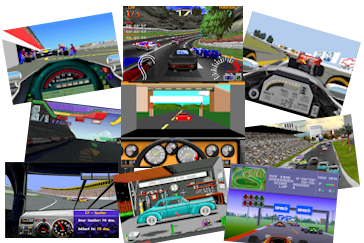 A lot changed over the course of 11 years, with hardware becoming increasingly capable of supporting 3D models, more detailed backdrops and better physics. But hardware isn't everything - the fun factor is what I would like to capture, and I'm sure there will be some surprises along the way!
A lot changed over the course of 11 years, with hardware becoming increasingly capable of supporting 3D models, more detailed backdrops and better physics. But hardware isn't everything - the fun factor is what I would like to capture, and I'm sure there will be some surprises along the way!
So where to begin? I think chronologically is as good as any, but I'll provide some quick links below in case you wish to jump directly to a specific title. For many of these titles, I have a dedicated game page which provides helpful hints on how to get the game installed and running optimally. Since I've not conducted a review of some of these before, it will also form the basis for the review on the game page.
How to rate a game? As I mentioned, it's not all about graphical fidelity and realistic engine noise, though I will definitely have both graphics and sound on my list of criteria. The fun factor is tricky, since some gamers like to immerse themselves in a full-blown simulation while others prefer a quick arcade-like blast around a circuit. Replayability/longevity is also a worthwhile rating - does the game have you coming back for more? You will no doubt come up with different ratings for these games than me, and I'm sure nostalgia will play a part in that as well. I remember playing Test Drive II: The Duel in 1990, and thinking it was really great; especially with the add-on scenery and car packs. These days, though, has it stood the test of time to make it worthwhile in 2023? Let's see.
Listing of DOS racing game titles in chronological order:
Part 1 - The Late 80s
|
Part 3 - 1993-1995
|
Test Drive (Electronic Arts, 1987)
See also Test Drive: Full review
Electronic Arts began as a software house back in 1982 on the 8-bit home computers, but they didn't try their hand at a 'simulator' until 1987 with the release of Test Drive. Simulators of all kinds in this era were pretty basic, and this game was no exception. However, the concept of being behind the wheel of a supercar was pretty new. Test Drive hands you the key to 5 sports cars - the Chevrolet Corvette, Ferrari Testarossa, Lamborghini Countach, Lotus Esprit, and the Porsche 911. Given that these are road-legal vehicles means you're out on the streets, or more specifically you're on a mountain pass.
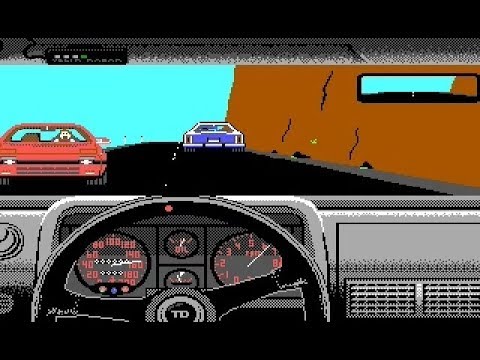 The aim of the game is to drive through five levels in the fastest time possible. The police are out in force, ready to stop any drivers with a heavy right foot and give you a speeding ticket which acts as a time penalty. Each car has a radar detector at the top of the screen that indicates when you're getting picked up on the police scanner - this gives you an idea of the distance between you and the cops. Get stopped too many times and it's game over, so you have to decide whether it's worth your while trying to outrun them or pull over and face the penalty. It's all done very well, and adds to the fun of the game.
The aim of the game is to drive through five levels in the fastest time possible. The police are out in force, ready to stop any drivers with a heavy right foot and give you a speeding ticket which acts as a time penalty. Each car has a radar detector at the top of the screen that indicates when you're getting picked up on the police scanner - this gives you an idea of the distance between you and the cops. Get stopped too many times and it's game over, so you have to decide whether it's worth your while trying to outrun them or pull over and face the penalty. It's all done very well, and adds to the fun of the game.
As you navigate along the mountain road you will be faced with traffic in both directions, in addition to other natural hazards like simply falling over the edge or hitting fallen rocks.
You have the choice of automatic or manual gears, and in manual mode you need to move the joystick in the direction of the chosen gear as it would be in the gait, which appears as a small window in the lower right corner. This gives a slightly added sense that the designers wanted Test Drive to be more simulation than arcade racer.
 Graphically the game was a mix. The car selection screens are well presented with a lot of each car's specifications and torque curves shown, and in-game the dashboard of each of the five cars reflects that actual layout of the real thing; little details like the Corvette's digital speedo add to the sense you are in that actual car. Sadly the view out of the windscreen is pretty hamstrung - the venerable IBM PC in 1987 really was still a business machine first and foremost, and had several graphics standards that any games developer would need to support to reach the largest audience. Test Drive runs happily on an XT (8088 or 8086) with graphics support for Hercules, CGA, Tandy/PCjr and EGA. This means 320 x 200 resolution in 16 colours is the best you're going to get.
Graphically the game was a mix. The car selection screens are well presented with a lot of each car's specifications and torque curves shown, and in-game the dashboard of each of the five cars reflects that actual layout of the real thing; little details like the Corvette's digital speedo add to the sense you are in that actual car. Sadly the view out of the windscreen is pretty hamstrung - the venerable IBM PC in 1987 really was still a business machine first and foremost, and had several graphics standards that any games developer would need to support to reach the largest audience. Test Drive runs happily on an XT (8088 or 8086) with graphics support for Hercules, CGA, Tandy/PCjr and EGA. This means 320 x 200 resolution in 16 colours is the best you're going to get.
Sound is one negative aspect of Test Drive. Only the PC speaker is supported, since the Ad Lib sound card didn't arrive until later on this same year. Still, Electronic Arts did what they could, with engine sounds, tyres squealing if you attempt to corner too fast, and the police car sirens. I've heard worse from the PC speaker, so it's best to just accept this was normal PC gaming life in 1987.
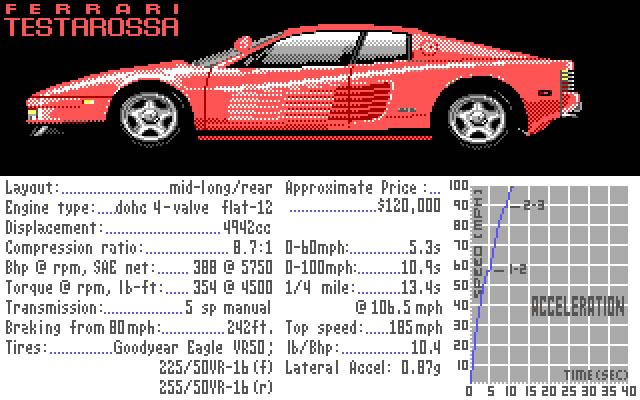 Is the game still fun to play in 2023? I'd have to say no. Unless you have a good dose of nostalgia for the game, it's tough to get past the rudimentary 16-colour graphics and PC speaker music and sound effects today. Test Drive will go down in history almost as the grandfather of the car driving simulation, but it hasn't aged well. If you're going to try Test Drive my recommendation is to skip it and load up the sequel, Test Drive II: The Duel, along with the expansion packs that give you more 'tracks' and cars, as well as direct competition against a computer opponent.
Is the game still fun to play in 2023? I'd have to say no. Unless you have a good dose of nostalgia for the game, it's tough to get past the rudimentary 16-colour graphics and PC speaker music and sound effects today. Test Drive will go down in history almost as the grandfather of the car driving simulation, but it hasn't aged well. If you're going to try Test Drive my recommendation is to skip it and load up the sequel, Test Drive II: The Duel, along with the expansion packs that give you more 'tracks' and cars, as well as direct competition against a computer opponent.
Sound: Not great, but it's of its time with PC speaker sound only, and no 3-voice audio for Tandy owners. Given this hardware limitation the intro music and in-race sounds are acceptable. It would have been great if Electronic Arts had released an Ad Lib patch for Test Drive after the event, but I guess the game was too hard-coded in this area to make it viable. 1/10
Gameplay: Still more arcade than sim, what would otherwise make Test Drive relatively boring is spiced up with the police chases and risk of getting tickets. There is no AI to speak of - cars just appear randomly to get in your way. The choice of using a joystick is a nice addition, though I personally prefer using the keys. 4/10
Lastability: Sadly only one 'track' is available (this limitation was corrected with its sequel), but the variety of cars to try out gives the game a bit more interesting to play for more than a few minutes. Sadly, there's not as big of a difference between them apart from the cosmetics in the interior to make this last. 3/10
OVERALL: 3/10
Grand Prix Circuit (Accolade, 1988)
I did a full review of Grand Prix Circuit back in June 2022, so I recommend you read that. I have vague recollections of playing this game in the late 90s. Grand Prix Circuit pre-dated Indianapolis 500, Ferrari Formula One and Vette! by a whole year, 4D Sports Driving by two years, and it would be three years for the mighty Formula One Grand Prix to appear in our shops. As such, by 1988 there really hadn't been any Formula One racing titles on the PC with which to compare. In fact, only Pole Position (1986) comes to mind, to which GPCircuit is streets ahead (mind the pun).
.jpg) The Distinctive Software team of Don Mattrick, Rick Friesen, Brad Gour, John Boechler, Amory Wong and Tony Lee worked off the back of their successes with Test Drive (1987), and put their gained knowledge to good use with this title. What a shame they missed the sales whirlwind of Ad Lib audio by just a smidge, as having nicer FM synthesis for music and sound effects would have made this game so much better!
The Distinctive Software team of Don Mattrick, Rick Friesen, Brad Gour, John Boechler, Amory Wong and Tony Lee worked off the back of their successes with Test Drive (1987), and put their gained knowledge to good use with this title. What a shame they missed the sales whirlwind of Ad Lib audio by just a smidge, as having nicer FM synthesis for music and sound effects would have made this game so much better!
Grand Prix Circuit gives you the option of racing in three different Formula One cars: Ferrari 187/88C, Williams FW12, and McLaren MP4/4. That's in order of power/difficulty, so the Ferrari has best handling of the three but is a bit slower. The Williams is middle of the pack speed-wise and also with handling and braking. Finally the McLaren is the fastest, but is therefore more difficult to drive when it comes to handling, braking, etc. It makes sense based on the 1988 season, as the McLaren Honda car was just unstoppable. In 1987, the Williams Honda car was pretty exceptional, and over both years, the Ferrari picked up a few wins here and there.
.jpg) Tracks-wise you don't get the full complement of an F1 season, but there are 8 circuits. These roughly resemble the actual track layouts at Brazil, Monaco, Canada, Detroit, Britain, Germany, Italy and Japan. The ones that are missing are San Marino, Mexico, France, Hungary, Belgium, Portugal, Spain and Australia.
Tracks-wise you don't get the full complement of an F1 season, but there are 8 circuits. These roughly resemble the actual track layouts at Brazil, Monaco, Canada, Detroit, Britain, Germany, Italy and Japan. The ones that are missing are San Marino, Mexico, France, Hungary, Belgium, Portugal, Spain and Australia.
All in all, Grand Prix Circuit was by far the best arcade-style Formula 1 simulation available for the PC at the time it was introduced. It was easy to get into for beginners, but fiendishly difficult to master at the higher skill levels. The other driver AI is also good, with each opponent having their own 'style' of driving, which you can get to learn. Don't expect a full-on sim here, though - there are no tyre temps, camber settings or downforce settings in sight. Nor are the drivers named after true Formula One drivers (you can see they are a take on the game's authors).
Sound: Hmm, not great here. It's PC speaker sound only, and no 3-voice audio for Tandy owners. Kris Hatlelid did a passable job of the main theme using the single-channel PC speaker, and given this hardware limitation the in-race sounds are also acceptable with usefully recognisable revs of the engine and the squeal of tyres when you're about to lose it. Shame they never provided an Ad Lib option. 4/10
Gameplay: GPC is extremely accessible for those who are coming to the game for the first time, but gives you a good sense of progress the more you practice. Starting off in the Ferrari with an auto box is advisable to get used to the circuits and how the other drivers behave, and soon your lap times will improve. The driving itself is relatively basic with turns of varying sharpness, so getting your speed right through each corner is important. 7/10
Lastability: Despite the simplicity of the game (it's very arcade-y for a sim), it keeps you coming back for more. This is aided by the number of difficulty levels, tracks and cars you can choose from. There are also a few visual aids such as the map box and info box that you can use in the early hours of playing the game to help you get used to the track layout, then switch them off for more of the challenge. Your opponents can do silly things from time to time, but understanding they're all a bit different gives you an opportunity to apply some strategy to beating them. 8/10
OVERALL: 7/10
Lombard RAC Rally (Europress / Mandarin Software, 1988)
I remember having this game back in 1990 on my first ever PC - a Hercules green-screen XT with single floppy drive. Rally games have been around since the 8-bit home computers, but Lombard RAC Rally was the first I had seen where the view was from behind the wheel (or more specifically, from the back seat!). It was incredible for the time and a first that depicted a complete stage of the World Rally Championship with the Lombard RAC Rally in the UK.
Lombard North Central had financially backed the event since 1977, alongside the RAC (Royal Automobile Club). With its 425 miles of scenic forest roads, difficult hills and curves, and variable weather, this final stage held across the UK was the most popular. In the 1988 rally, we saw iconic cars such as the Ford Sierra RS Cosworth, Lancia Delta Integrale and Toyota Celica GT-4 test their mettle on the tough courses.
 In this game, Mandarin Software did a decent job of capturing the spirit of the rally championship. Not only can you be the driver, you can change some settings of your car in the workshop, and you can earn money by taking part in a TV interview. The various rally stages are available to drive, with road, mountain and forest legs. The view is from just behind the navigator and driver - for the navigator, rather than hearing or seeing voice annotations like 'four right', or 'five left, don't cut', you simply see a map of the route and how far you've got to on a clipboard in the navigator's hands. On the right sits the driver whose hands move with the steering input and he changes gear when you do - a nice touch. The speedometer and rev counter also move according to your speed and engine revs, as you would expect. The only other item that changes in the vehicle are the two clocks - the top one provides your total time so far across the whole rally stage, and the lower one on the clipboard gives you the elapsed time for the current leg.
In this game, Mandarin Software did a decent job of capturing the spirit of the rally championship. Not only can you be the driver, you can change some settings of your car in the workshop, and you can earn money by taking part in a TV interview. The various rally stages are available to drive, with road, mountain and forest legs. The view is from just behind the navigator and driver - for the navigator, rather than hearing or seeing voice annotations like 'four right', or 'five left, don't cut', you simply see a map of the route and how far you've got to on a clipboard in the navigator's hands. On the right sits the driver whose hands move with the steering input and he changes gear when you do - a nice touch. The speedometer and rev counter also move according to your speed and engine revs, as you would expect. The only other item that changes in the vehicle are the two clocks - the top one provides your total time so far across the whole rally stage, and the lower one on the clipboard gives you the elapsed time for the current leg.
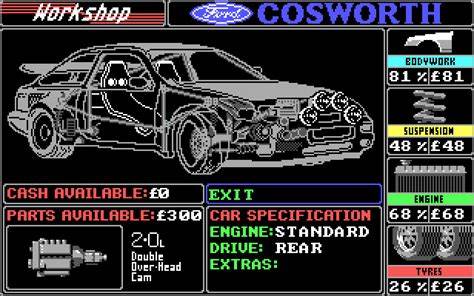 You get more cash the higher up the ranking you get, and you can spend it to repair your car's bodywork, suspension, engine and tyres, as well as fitting new parts to improve the car.
You get more cash the higher up the ranking you get, and you can spend it to repair your car's bodywork, suspension, engine and tyres, as well as fitting new parts to improve the car.
The outside graphics are somewhat basic, with a graduating road surface to show forward motion and distance, and a graduating sky. In its 16-colour EGA, it looks rather garish but works fairly well. Something that Mandarin did to add to the realism was the inclusion of both day and night driving, and also inclement weather.
 The sound in the game is, sadly, PC speaker only. Like other driving games from the year before (Test Drive, Grand Prix Circuit, etc)., there's no provision for the Ad Lib card, which is a real shame. Still, for its time, the beeps and bloops put into the game work well to give you the necessary indication of your current engine revs and when you're off the road or hit something.
The sound in the game is, sadly, PC speaker only. Like other driving games from the year before (Test Drive, Grand Prix Circuit, etc)., there's no provision for the Ad Lib card, which is a real shame. Still, for its time, the beeps and bloops put into the game work well to give you the necessary indication of your current engine revs and when you're off the road or hit something.
The controls are simple - accelerate, brake, steer left and right, and change gears - and they do as you would expect. The game is quite accessible, even for a novice, though you do have the option to practice before going for the best time on a leg.
Overall, Mandarin did a good job of putting as much into the game as they could to represent driving in a rally. You can save and load a driver at a given point so if you do mess up you can reload that driver from the last save point you made, and this allows you to progress through the game more easily. It's not overly easy, and upgrading/repairing your vehicle becomes necessary as you go along.
Sound: Yeah, not great with PC speaker sound only, and no 3-voice audio for Tandy owners. Given that the Ad Lib card was out by this point, why didn't they program an audio option for it? 3/10
Gameplay: Driving gets a bit monotonous after a short while - there's really not enough difference in the scenery to keep you interested from one leg to another. The driving itself is basic, and since this is the biggest part of the game, it's lacking. The rest of the game adds some decent rally-related content helps knit the whole game together into something more than just a basic driving sim. 4/10
Lastability: The fact you can save your driver's progress is a nice touch, allowing you to come back for more when you get tired of switching your eyes between the navigator's clipboard and what's going on out the window. Adding goodies to your vehicle with the money you earn also gives this game an edge when it comes to replayability. 6/10
OVERALL: 4/10
Ferrari Formula One (Electronic Arts, 1989)
Ferrari Formula One is a racing simulation with a decent amount of gameplay. Not only do you get to practice, qualify and race the full 1986 season of 16 tracks, but the game also involves you in setting and testing your car's aerodynamics and engine. This takes place back at the Ferrari headquarters and test track at Fiorano, Italy. The various stages of preparing your car for each main race are time-constrained, just like in real life. For example, it may take 45 minutes to replace your car's engine if you blow it during practice, and if there is insufficient game time remaining before the race starts, it won't allow you to fit it. This adds a further dimension to the game which is great!
.png) For each race there are two practice sessions followed by two qualifying sessions and in each of these you can adjust your car's settings. If you're not sure what a good car setup is, the game has a built-in crew chief called Mauro, who you can call up to see his recommendations. The four pre-race sessions are followed by the race itself. As you would expect, your starting position in the race is determined by your best lap time during the two qualifiers.
For each race there are two practice sessions followed by two qualifying sessions and in each of these you can adjust your car's settings. If you're not sure what a good car setup is, the game has a built-in crew chief called Mauro, who you can call up to see his recommendations. The four pre-race sessions are followed by the race itself. As you would expect, your starting position in the race is determined by your best lap time during the two qualifiers.
.png) Ferrari Formula One is probably the first true Formula One racing simulation, rather than the more arcade-like Grand Prix Circuit. The game is difficult to master but this is by design - as Rich Hilleman, Associate Producer at Electronic Arts said back in 1988, it is a grand prix simulation as opposed to a racing game. Does this make it a better game? That depends on what you're looking for - this added complexity and steeper learning curve might make it less 'fun' for some, but if you want a more immersive Grand Prix racing experience, Ferrari Formula One checked the boxes better than anything that came before it.
Ferrari Formula One is probably the first true Formula One racing simulation, rather than the more arcade-like Grand Prix Circuit. The game is difficult to master but this is by design - as Rich Hilleman, Associate Producer at Electronic Arts said back in 1988, it is a grand prix simulation as opposed to a racing game. Does this make it a better game? That depends on what you're looking for - this added complexity and steeper learning curve might make it less 'fun' for some, but if you want a more immersive Grand Prix racing experience, Ferrari Formula One checked the boxes better than anything that came before it.
What a shame such a well-rounded game is let down by two key things: the weird design choice of having a moving cockpit when you corner and terrible sound. These alone make Ferrari Formula One a painful experience to play, enough to mark it down.
Sound: Like other 1989 titles here, the game is let down by poor sound support on the DOS version, only using the PC speaker. Even if done well, a single channel of sound in a game with a screaming F1 car is never going to be a good thing, though Grand Prix Circuit from a year earlier managed it so much better than this. With engine sounds on, driving is nothing short of jarring and will have you reaching for the sound option pretty quickly to switch it off. 1/10
Gameplay: When actually racing, the biggest gripe I had was the view of the car when cornering - go round a right hand corner and your whole car shifts to the left - go left and the whole car shifts to the right. I guess they were trying to mimick where the driver's eyes would be going through the corner. Personally I dislike this - it's very offputting for a while until you learn to almost ignore the bottom of the screen and focus on the view ahead. It would have been nice to have an option to switch this 'effect' off. The other negative to point out is that your car bounces off the chevrons when you get too close - not at all realistic. Most racing games simply cause your car to slow down drastically if you go off the track. The car setup process is very well done, and having Mauro to help you with a workable car setup for the current track is a welcome addition. The fact that time passes when events take place also adds to the realism of being there at a Formula One circuit for the race weekend. Huge props to EA here for not only making a game that's more sim than arcade when in the cockpit, but also for adding those ancillary portions that bring it all together into a well-rounded experience. It's sad that a few game design decisions really kill what would otherwise have been good. 5/10
Lastability: With a whole season of racing and a choice of three teams to choose from there is plenty to keep you occupied in this game. As mentioned, it's not for some and will take a bit of getting used to, but the ability to fine-tune your car to get the most out of it and then seeing the results really make this more of a serious simulator that can provide you with many hours of fun. 7/10
OVERALL: 5/10
Indianapolis 500: The Simulation (Papyrus, 1989)
1989 saw us entering into a new era of graphical detail with the launch of the very first DOS game with 3D polygons. Papyrus Design Group released the single-circuit Indianapolis 500: The Simulation which was met with critical acclaim. While it only had the one circuit (obviously), the game comprised possibly the most flexible car setup physics seen to date including front and rear spoiler downforce, outer and inner tyre pressures and compounds, camber, shock firmness, wheel stagger, gear ratios and fuel weight.
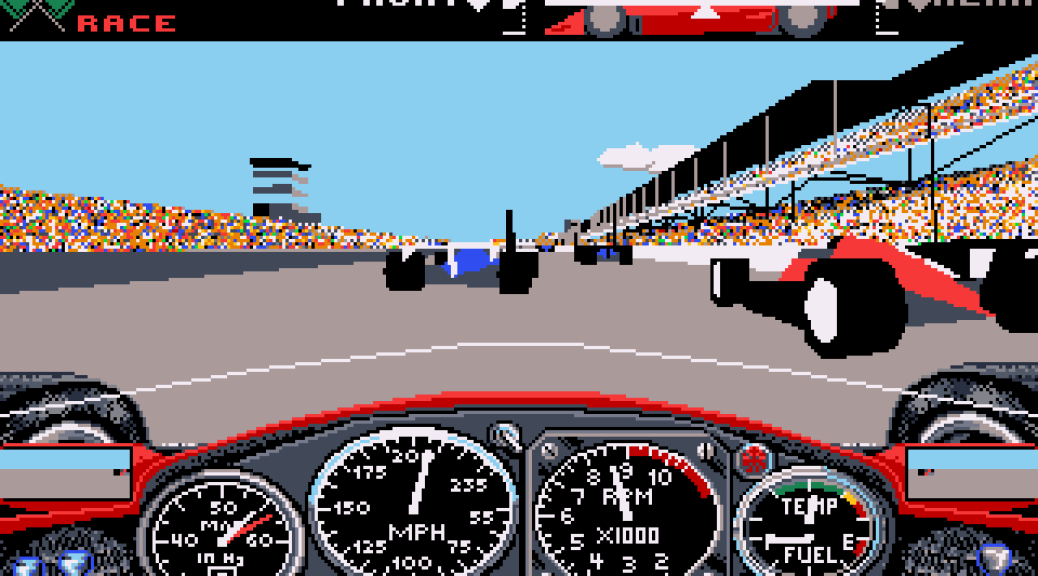 You could decide between three Indy cars: March/Cosworth (the easiest car to handle but also the slowest), Lola/Buick (faster than the March but more difficult to handle), or Penske/Chevrolet (the fastest and most difficult to handle). To make this a full Indy 500 experience, all the rounds were included in the game, from practice, to a four-lap qualifying round which determined your grid position for the race, and finally the race itself. During practice and qualifying sessions you see other cars out on the circuit doing the same thing.
You could decide between three Indy cars: March/Cosworth (the easiest car to handle but also the slowest), Lola/Buick (faster than the March but more difficult to handle), or Penske/Chevrolet (the fastest and most difficult to handle). To make this a full Indy 500 experience, all the rounds were included in the game, from practice, to a four-lap qualifying round which determined your grid position for the race, and finally the race itself. During practice and qualifying sessions you see other cars out on the circuit doing the same thing.
The race itself pits you against 31 other cars which are controlled by the computer.
 While fairly basic, the car models were so much better than anything that we'd seen before, and because they were in a fully 3D environment with all the physics that came with it, they could be viewed from any angle. At any time you could pause the action to take in the last 20 seconds via the 'Instant Replay' feature which provided five camera views: In-car, Behind, Track, TV, Sky and Leader (same as TV but focussed on the race leader).
While fairly basic, the car models were so much better than anything that we'd seen before, and because they were in a fully 3D environment with all the physics that came with it, they could be viewed from any angle. At any time you could pause the action to take in the last 20 seconds via the 'Instant Replay' feature which provided five camera views: In-car, Behind, Track, TV, Sky and Leader (same as TV but focussed on the race leader).
Car setup was performed in the pits using the function keys - basic but it did the job. Three car setups could be saved or loaded from disk once you had everything configured to your liking.
 Crashes were common and fun to watch/replay, and the crashed cars remain on the circuit during the race, to be avoided on subsequent laps!
Crashes were common and fun to watch/replay, and the crashed cars remain on the circuit during the race, to be avoided on subsequent laps!
All in all, Indianapolis 500: The Simulation was groundbreaking, and a sign of things to come. Yes, it was basic in its content with just the one oval circuit and a 20-second replay capability, but it was still much more than a prototype game - the car drove extremely well, the AI was better than expected with other cars occasionally crashing into each other without you being involved, and to top it off, the game still ran well on older hardware.
Sound: Another first... we get Ad Lib and Roland MT-32 sound options, both of which were brilliantly executed. The engine scream, tyre squeal, crashes, and intro tune make Indy 500 an appealing title to come back to without fear of having to listen to the dreaded PC beeper. 8/10
Gameplay: A true simulator, with just about every car setup option you could have available to you, and changing these had a material difference when out on the oval - get the camber wrong, or tire pressures, and you'd find yourself unable to turn well, or your tyres would heat up too much and degrade, risking a blowout. Despite being only on the single oval circuit at Indianapolis, it didn't matter, because there was still so much to do to perfect your lap times. The rules of Indy 500 were also modelled with yellow and black flags, and you had to come in to refuel or change tyres periodically. The damage model was also groundbreaking - you could have a minor shunt which might impact your downforce, or blow your engine in a bigger collision putting you out of the race. The choice of 10 laps, 30 laps, 60 laps or the real thing: 200 laps was also a nice choice. 8/10
Lastability: For those with patience, Indy 500 offered a lot of game for 1989, where it was easy to spend several hours tweaking one of the car setups and taking it for a spin to see how the car handled, then trying it out under race conditions. 7/10
OVERALL: 7/10
Test Drive II: The Duel (Accolade, 1989)
See also Test Drive II: Full review
Test Drive II: The Duel took the original game and added a single opponent to race against. Unlike the five cars you got in Test Drive, there was now only two: the Ferrari F40 and Porsche 959. The game adds the concept of three lanes in some places, a working rear-view mirror that shows what's going on behind you, and some other niceties that give you more control, such as the need to actually stop at gas stations close to the pump to complete the stage. The in-car dashboards retain their authentic look from the first game, which was always considered a nice feature.
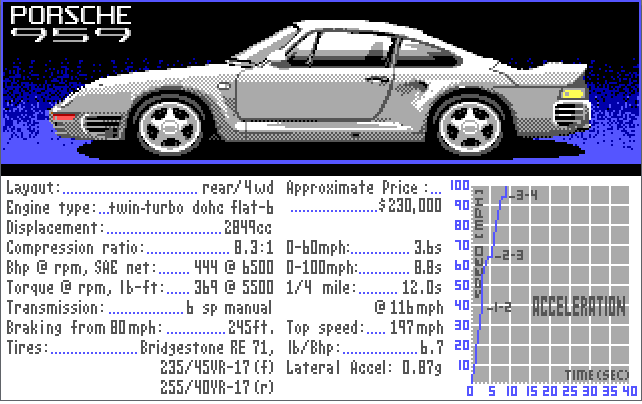 Test Drive II's enhancements are all very welcome, and overall make the game a more enjoyable experience that will cause you to want to spend more time playing. The police are not only on the roads, but can also be seen trying to flag you down by the side of the road. The addition of 12 skillsets similar to Accolade's Grand Prix Circuit give you the chance to use an automatic gearbox in the easier ones as well as slower opponents and less dense traffic, making the game more accessible to beginners. More more of a challenge, skill levels 5 to 12 provide a progressively more difficult experience, all with you wrangling with a manual gearbox. The computer opponent uses more of his car's speed, the police are faster too, and the traffic density increases. On the plus side, completing sections will net you more points the higher up the skill ladder you choose.
Test Drive II's enhancements are all very welcome, and overall make the game a more enjoyable experience that will cause you to want to spend more time playing. The police are not only on the roads, but can also be seen trying to flag you down by the side of the road. The addition of 12 skillsets similar to Accolade's Grand Prix Circuit give you the chance to use an automatic gearbox in the easier ones as well as slower opponents and less dense traffic, making the game more accessible to beginners. More more of a challenge, skill levels 5 to 12 provide a progressively more difficult experience, all with you wrangling with a manual gearbox. The computer opponent uses more of his car's speed, the police are faster too, and the traffic density increases. On the plus side, completing sections will net you more points the higher up the skill ladder you choose.
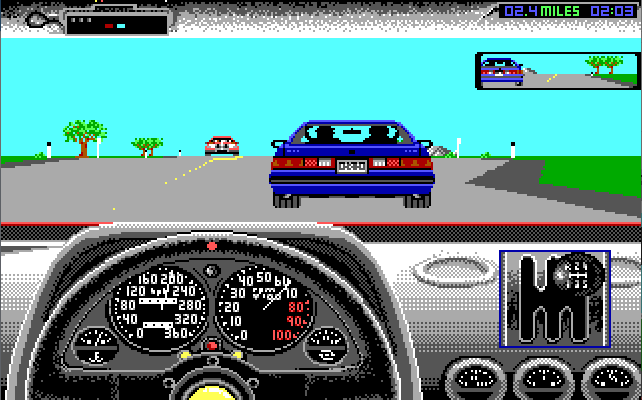 Apparently borrowing an idea from its golf games, Accolade/Distinctive added the option to load more scenery and cars. Test Drive II Scenery Disk: California Challenge provided you with a route from the Redwoods of Eureka down to the border of Mexico. Test Drive II: The Supercars added five news cars, many of which were present in the original Test Drive game: the RUF Twin Turbo, Lotus Turbo Esprit, Lamborghini Countach, Ferrari Testarossa, and the Chevrolet Corvette ZR1. A second 'car pack' called Test Drive II: The Muscle Cars added the Chevrolet Camaro ZL-1, Dodge Charger, Pontiac GTO, Shelby Mustang GT Cobra, and the Corvette Stingray. Finally, a second scenery disk, European Challenge, allowed you to take in the sights of The Netherlands, Germany, Switzerland, Italy, France and Spain.
All these add-ons can be installed at the same time - something other games with expansion pack offerings sometimes struggle with.
Apparently borrowing an idea from its golf games, Accolade/Distinctive added the option to load more scenery and cars. Test Drive II Scenery Disk: California Challenge provided you with a route from the Redwoods of Eureka down to the border of Mexico. Test Drive II: The Supercars added five news cars, many of which were present in the original Test Drive game: the RUF Twin Turbo, Lotus Turbo Esprit, Lamborghini Countach, Ferrari Testarossa, and the Chevrolet Corvette ZR1. A second 'car pack' called Test Drive II: The Muscle Cars added the Chevrolet Camaro ZL-1, Dodge Charger, Pontiac GTO, Shelby Mustang GT Cobra, and the Corvette Stingray. Finally, a second scenery disk, European Challenge, allowed you to take in the sights of The Netherlands, Germany, Switzerland, Italy, France and Spain.
All these add-ons can be installed at the same time - something other games with expansion pack offerings sometimes struggle with.
 Test Drive II still only supports 16-colour EGA graphics (320 x 200 resolution) and the PC speaker is all you get on the sound front. In its year of release (1989), games like Indianapolis 500: The Simulation, Prince of Persia, and Indiana Jones & the Last Crusade, all offered a 256-colour VGA version and sound options that included the Ad Lib card, so this is a poor show on the part of Distinctive/Accolade.
Test Drive II still only supports 16-colour EGA graphics (320 x 200 resolution) and the PC speaker is all you get on the sound front. In its year of release (1989), games like Indianapolis 500: The Simulation, Prince of Persia, and Indiana Jones & the Last Crusade, all offered a 256-colour VGA version and sound options that included the Ad Lib card, so this is a poor show on the part of Distinctive/Accolade.
TD2 is obviously based on the same code from the earlier Test Drive game - the driving dynamics are almost identical, apart from being able to go slightly off-road without crashing. Each vehicle could have been made more acute to help differentiate one over the other, and the crash sequence is the same.
Sound: As mentioned before, no improvement over the original Test Drive here, and for 1989 it really lets the game down. Every car sounds the same and the police scanner can get annoying fast. 1/10
Gameplay: Taking what was great about Test Drive and adding more to it is certainly very welcome. If it weren't for the expansion packs there's really not much extra that's worthwhile about TD2 unless racing against a computer opponent is the key missing piece for you. I personally consider TD2 to be nothing more than a 'decent' version of TD1. It's the same game, only more.5/10
Lastability: The car and scenery expansion packs give Test Drive II: The Duel the legs it needs in the lastability department (even if it was a blatant attempt to increase game revenues). Without these, TD2's updates wouldn't be enough to keep you coming back for more. But they have sufficient extra content to make them a worthwhile purchase.6/10
OVERALL: 5/10
Vette! (Spectrum Holobyte, 1989)
Spectrum Holobyte were known as a developer/publisher who pushed technological boundaries, and Vette! was no exception. The in-game graphics made use of 3D polygons (one of the first games to do so) and gave you the whole of San Francisco to explore. With a choice of four Chevrolet Corvette models to choose from and four circuits there was plenty of action to be had as you raced against a computer-controlled opponent driving a Porsche 928, Ferrari Testarossa or Ferrari F40.
 While the main event in the game was beating your opponent to the destination, you could decide on your own route for how to get there, making this completely "open world". Key landmarks such as Fisherman's Wharf and the Golden Gate Bridge are presented in more detail, but most buildings are simply rectangular blocks with a few exceptions such as gas stations. Still, the city is immersive and you do get the sense that it's a big place.
While the main event in the game was beating your opponent to the destination, you could decide on your own route for how to get there, making this completely "open world". Key landmarks such as Fisherman's Wharf and the Golden Gate Bridge are presented in more detail, but most buildings are simply rectangular blocks with a few exceptions such as gas stations. Still, the city is immersive and you do get the sense that it's a big place.
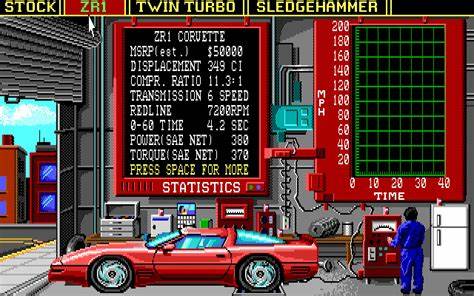 To add to the cityscape, roads were adorned with other moving vehicles to avoid including trucks, fire engines, bikes and a variety of different coloured cars. This level of immersion in an open-world driving game had not been seen since the days of Turbo Esprit by Durell Software on the 8-bit platforms.
To add to the cityscape, roads were adorned with other moving vehicles to avoid including trucks, fire engines, bikes and a variety of different coloured cars. This level of immersion in an open-world driving game had not been seen since the days of Turbo Esprit by Durell Software on the 8-bit platforms.
The static game screens were beautifully drawn, making use of EGA's high-resolution mode, and in-game the 3D graphics were basic but effective. If you had a relatively fast PC at the time, the game was a fairly enjoyable experience. Slower PCs of course incurred a slower frame rate, so these days the game is best played on a moderate 25 MHz 386 for best performance.
The game controls work well, with keyboard being the best choice here.
Sound: As I've said often in this article so far, the lack of any sound option apart from the PC speaker makes this another game that's a painful experience to play. It's best to switch off the engine sounds, but even the siren (which you'll hear quite often as you speed around the city) is shrill. 1/10
Gameplay: Simply excellent - an open world 3D polygon-filled city to explore, and it's 1989! Spectrum Holobyte/Sphere are to be applauded for squeezing so much into a game that can run on very old PC hardware. The races are good, though given that you can pick your own route, it's easy to cheat, and this gets boring pretty quickly. The best aspect of this game is its 'Explore' mode which gives you time to cruise the streets and take in the sights. Spectrum Holobyte also provided a 2-player mode in Vette!, able to connect either via direct cable connection or modem so you can compete in races against a friend. 9/10
Lastability: Once you've toured San Francisco and done a few races, there is little to keep you interested beyond the first hour. There are four different variants of Corvette, which up the skill level needed to drive them as your computer-controlled opponent is faster as your car's specs improve, though this isn't going to keep your attention longer-term. 5/10
OVERALL: 7/10
So closing out this first batch of DOS driving games from the late 1980s, I landed on the following scores:
|
|
|
|
|
|
|
Head over to Part Two, where we begin the 1990s and 3D polygon-filled games are here to stay!






